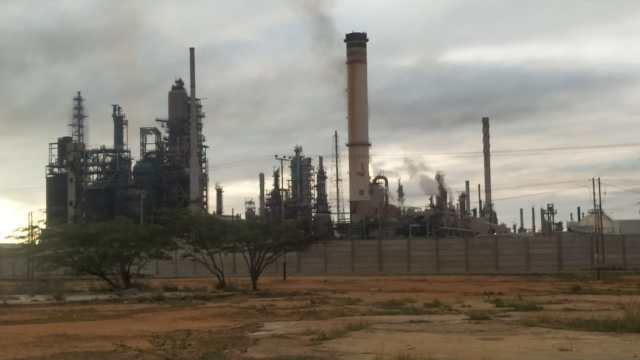
The lines to resupply fuel in Venezuela are not improving, and an example of this is what is experienced in Falcón State in north western Venezuela, where the two largest refineries in the country are located. Restrictions have been established for all vehicles to fill up with subsidized gasoline using the Patria System according to license plate terminal number, and there are very few service stations that provide this subsidized service since most offer fuel at international prices in hard currency cash or the ever increasing exchange rate. Although there is usually no queue to get supplies at these stations, there are weeks in which the distribution fails and this puts more than one scrambling to end fuel.
By Irene Revilla // Correspondent lapatilla.com
Two refineries are located in the Paraguaná Peninsula in Falcón State (Amuay and Cardón). These make up the Paraguaná Refining Complex (CRP). They both have a combined installed production capacity of 955,000 barrels per day. However, in recent years, production has plummeted and the lack of gasoline in the country has worsened. PDVSA does not provide information in this regard, so everyone resorts to confirmed information offered anonymously by oil workers.
As of October 10th, only the Cardón refinery is producing some gasoline through the reformer and catalytic plants, while the Catalytic Cracking Unit (DCAY) remains off-line waiting for supplies. Oil workers report that only the distillers that process light crude oil arriving from Zulia State are operational, but that is insufficient for the amount of hydrocarbon input that DCAY needs to get going, so it remains in recirculation mode, started up but not producing.
The only distillers that are operating are Nº 1 and 2, which process light crude oil, while 3, 4 and 5 process heavy crude oil that arrives from eastern Venezuela and with their production DCAY could be restarted. These three plants are out of service: two of them (3 and 5) due to lack of preventive maintenance, while Nº 4 was affected by a fire on October 27th, 2022 in an alleged attack reported by Nicolás Maduro. Although at the moment improvements were announced for fuel production in the Falcón State, this has not been fulfilled.
Little distribution
Although the inhabitants of Falcon thought that the fuel shortage would never affect the region, because the refineries operate there, the situation is not different from that of other states in Venezuela. Drivers still queue for days to fill their tanks with subsidized fuel, even if they live in front of one of the two refineries.
What “saves” Falcón users is gasoline sold Lin hard currency at international prices (0.5 cents per liter), which rarely goes missing. In the region, fuel is available every day at a “dollarized” (foreign currency) price, and whether you must pay in hard foreign cash or in local currency at the current exchange rate depends on the demands of each service station.
A service station attendant who preferred not to identify himself said that PDVSA passes on information about the distribution daily. “We almost always have gasoline, maybe people don’t fill the tank completely. Most buy only five or 10 dollars. There are very few who spend more than 20 dollars on gasoline.”
At the end of September there were two critical weeks in the region: gasoline did not arrive, not even to dollarized stations. Of course, queues were seen at all service stations. According to information from the workers, this was caused by problems with several tanker trucks.
“Many are already inoperative and this is not enough to supply fuel. Some drivers had not been paid and stopped working for a few days. That generated chaos throughout the state and alarm among people who always try to have a full tank in case there is an emergency. The crisis lasted a few days, because the plan to supply only the dollarized service stations on a daily basis was re-assembled. We are waiting for a fleet of replacement tanker trucks to mitigate this problem, we hope they arrive soon,” he said.
There is no more gasoline for the sick
When the Covid-19 pandemic arrived, the gasoline shortage also worsened, so plans were made to give preference to kidney patients or patients with chronic diseases who could not wait in line to obtain fuel and receive their treatments. However, more than six months ago this preference and subsidy was taken away and each patient is on its own as far as transportation goes.
The same thing happened with healthcare personnel who provide services in the state’s hospitals and public outpatient clinics. The only ones who are receiving a fuel subsidy are the oil workers and they have been decreasing the fuel allotment: from 40 liters a week they reduced it to 30 liters, and now they get between 20 and 25 liters, this depending on the amount of gasoline that reaches the service where they fill up.
The lapatilla.com team requested information from PDVSA and Falcón State’s government about the production and distribution of gasoline, but no response was obtained.

